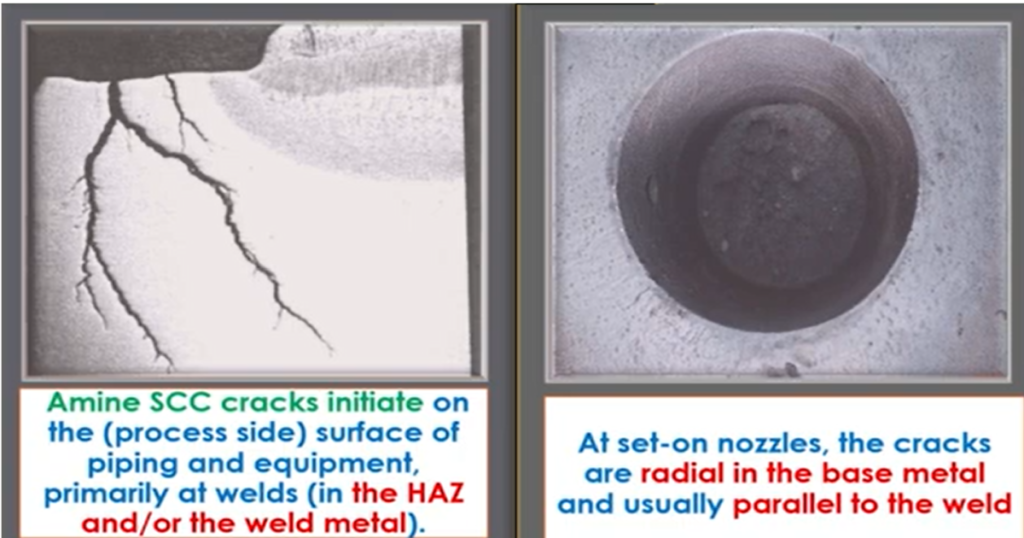Amine Stress Corrosion Cracking (ASCC) is a type of stress corrosion cracking (SCC) that occurs in equipment and pipelines used in amine gas treating units in the oil and gas industry. Amine gas treating is a common process used to remove acidic components such as hydrogen sulfide (H2S) and carbon dioxide (CO2) from natural gas and refinery process streams.

Amine Stress Corrosion Cracking Explanation.
Amine Stress Corrosion cracking is also referred as Amine cracking, is another form of
alkaline stress corrosion cracking found in the equipment handling various
alkanolamines used for the H2S stripping.
The cracking is more common in the equipment which carry the residual stressed from welding and cold forming. Most critical factors for this kind of cracking are the process temperature, and amount of accumulated stresses, however concentration of the amine does not appear to have a significant effect on the tendency of cracking.
The susceptible equipment manufactured with carbon steel and low alloy steels in amine stripping units, especially in the sections handling lean amine. Post weld heat treatment is the best method to mitigate this damage. Other amine related damage mechanism is the generalized corrosion caused by rich amine (with high concentration of dissolved H2S).
Further details on this damage mechanism can be seen from API‐RP‐571 Para 5.1.2.2.
ASCC typically occurs in carbon steel equipment exposed to amine solutions under tensile stress. The presence of amines, such as monoethanolamine (MEA), diethanolamine (DEA), or methyldiethanolamine (MDEA), combined with applied or residual tensile stress, can lead to the initiation and propagation of cracks in susceptible materials.
The Mechanism.
The mechanism of Amine Stress Corrosion Cracking involves several factors:
- Amine Environment: Amines used in gas treating processes can form corrosive environments, especially at elevated temperatures and concentrations. These environments can promote the breakdown of the passive film on carbon steel surfaces, leading to localized corrosion.
- Tensile Stress: Applied or residual tensile stress, which can result from factors such as operational loads, thermal cycling, or welding processes, further exacerbates the susceptibility to cracking. Stress concentrations, such as welds or areas with geometric irregularities, are particularly vulnerable to crack initiation.
- Hydrogen Embrittlement: The presence of hydrogen, generated as a byproduct of the corrosion process, can contribute to hydrogen embrittlement of the metal. Hydrogen atoms can diffuse into the steel lattice, causing hydrogen-induced cracking and reducing the material’s ductility and toughness.
Prevention Strategies.
The consequences of Amine Stress Corrosion Cracking can be severe, leading to equipment failure, leaks, and potentially catastrophic incidents. Preventing ASCC requires a combination of measures:
- Material Selection: Choosing materials resistant to amine corrosion, such as stainless steels or corrosion-resistant alloys, can mitigate the risk of ASCC.
- Environmental Control: Maintaining optimal operating conditions, including controlling amine concentration, temperature, and pH, can help minimize corrosion rates and reduce the risk of cracking.
- Stress Management: Minimizing applied or residual tensile stress through proper design, fabrication, and installation practices is essential for preventing ASCC. Stress relief treatments and the use of stress-reducing features, such as fillet welds or smooth transitions, can help mitigate stress concentrations.
- Monitoring and Inspection: Regular inspection and monitoring programs are critical for detecting early signs of corrosion and cracking. Non-destructive testing techniques, such as ultrasonic testing and magnetic particle inspection, can help identify potential cracking sites before they lead to failure.
In conclusion, Amine Stress Corrosion Cracking is a significant concern in the oil and gas industry, particularly in amine gas treating units. By understanding the mechanisms driving ASCC and implementing effective prevention and mitigation strategies, operators can minimize the risk of equipment failure, ensure operational safety, and maintain the integrity of their assets. Vigilance, proactive maintenance, and continuous improvement efforts are essential for combating the threat of ASCC and safeguarding against potential incidents.